1. Helmet Vanga (Euryceros prevostii)

The helmet vanga is a strikingly colored bird in the vanga family, a family of passerine birds which are found only in Madagascar. The helmet vanga was first described in 1831 by the French naturalist R. Lesson.
The helmet vanga is quite large, 28 to 31 cm long. Its most striking feature is the big beak which is 5 cm long, has a bright blue color with a black tip. The helmet vanga is dark blue in color on the head, throat, neck, chest and belly and on the wing feathers and tail. It is also reddish brown above and for a large part on the wings. The long broad tail is black below and reddish brown above. The male and female do not differ in plumage. The helmet vanga is found in northeastern Madagascar in lowland forest and the lower regions of mountainside rain forests. We can find them in Marojejy National Park, Masoala National Park, Makira National Park and Mantadia National Park.
The bird lives in the rainforest and is therefore threatened by logging and habitat loss and it was listed as vulnerable on the IUCN Red List in 2000. The continuing deforestation is why the bird has been on that list as endangered since 2018 and can then be seen almost exclusively in nature parks.
2. Fossa (Cryptoprocta ferox)

The fossa (or ferret cat) is the largest native predator in Madagascar. Although the fossa looks like a cat in appearance, it belongs to a different family, the Madagascar civets (Eupleridae). It is the only living species of the subfamily Cryptoproctinae, but a second species, Cryptoprocta spelea, lived in the Pleistocene.
As the synonym suggests, the ferret cat somewhat looks like a feline. The fossa has a long, slender body with round ears and two large, forward-facing eyes. It is 60 to 90 centimeters long and typically weighs 7 to 14 kilograms. With a length of 55 to 90 centimeters, the tail is almost as long as the rest of the body. The fossa has a thick, short coat, reddish brown to dark brown in color. The fossa is a solitary animal. He can retract his nails.
The fossa can only be found in the forests of Madagascar. It hunts individually, mostly lemurs and birds in trees, but also eats bird eggs. The fossa is also a great hunter on the ground, where he mainly hunts for guinea fowls, tenrecs and snakes. The fossa is at the top of the food chain in Madagascar. He is a good climber which can often be seen in trees and jumps with ease from branch to branch. The animal hunts mainly at night, but can also be seen hunting during the day. He rests in a hollow tree or a hole in the ground, where it also eats its prey.
Fossas are solitary animals. It is only during the mating season, from September to October when they live in temporary groups. During the mating season, female fossas stay high up in the trees, under which several males gather. The males then start to fight among each other and call for permission to mate with the female. The female then mates with several males. The mating can sometimes last over two and a half hours and the male sometimes remains attached, just like dogs. After a week, another female comes to take her place and mates with the remaining males.
After a period of 10 weeks, the female fossa gives birth to two to four cubs, usually in a hollow tree or hidden between rocks. The young fossas weigh only 80 to 100 grams when they’re born and their eyes only open after 16 to 25 days. After three months they start to eat solid food and after four months they are weaned. The fossa is fully grown and sexually mature when it’s about four or five years old.
Female fossas undergo a “masculine” period during adolescence: the clitoris grows considerably, is supported by a small bone, and spines grow on it, like the penis of an adult fossa. Glands on the underside also secrete an orange fluid, just like adult males. The fossa is the only animal species known to have such a “male” phase.
3. Madagascar Serpent Eagle (Eutriorchis astur)

The Madagascar snake eagle is a bird of prey in the family Eutriorchis , which was first described by Richard B. Sharpe in 1875 and depicted in the same publication by J. G. Keulemans. The Madagascar snake eagle is a rare and endangered endemic bird species from Madagascar.
The Madagascar snake eagle is a medium-size bird of prey who measures from 57 to 66 cm long and its wingspan is 90 to 110 cm. The bird has a long rounded tail and short, rounded wings. It is dark gray in color on top, and the plumage on the belly and chest is light gray with horizontal stripes.
The Madagascar serpent eagle can mainly be found in the rainforests of Madagascar, and research after 1995 showed that the bird was less rare than previously thought and also occurs in more places in Madagascar. Its habitat is lowland and mid-mountain rainforest and it doesn’t go higher than 550 m altitude. The Madagascar serpent eagle rarely leaves the rainforest and hunts low above the tree canopy for lizards, snakes and chameleons, which makes it hard to observe them.
There are an estimated 250 to 1000 individuals. Because of habitat fragmentation and deforestation,, the Madagascar snake eagle is listed as endangered on the IUCN Red List.
4. Tenrecs (Tenrecidea)
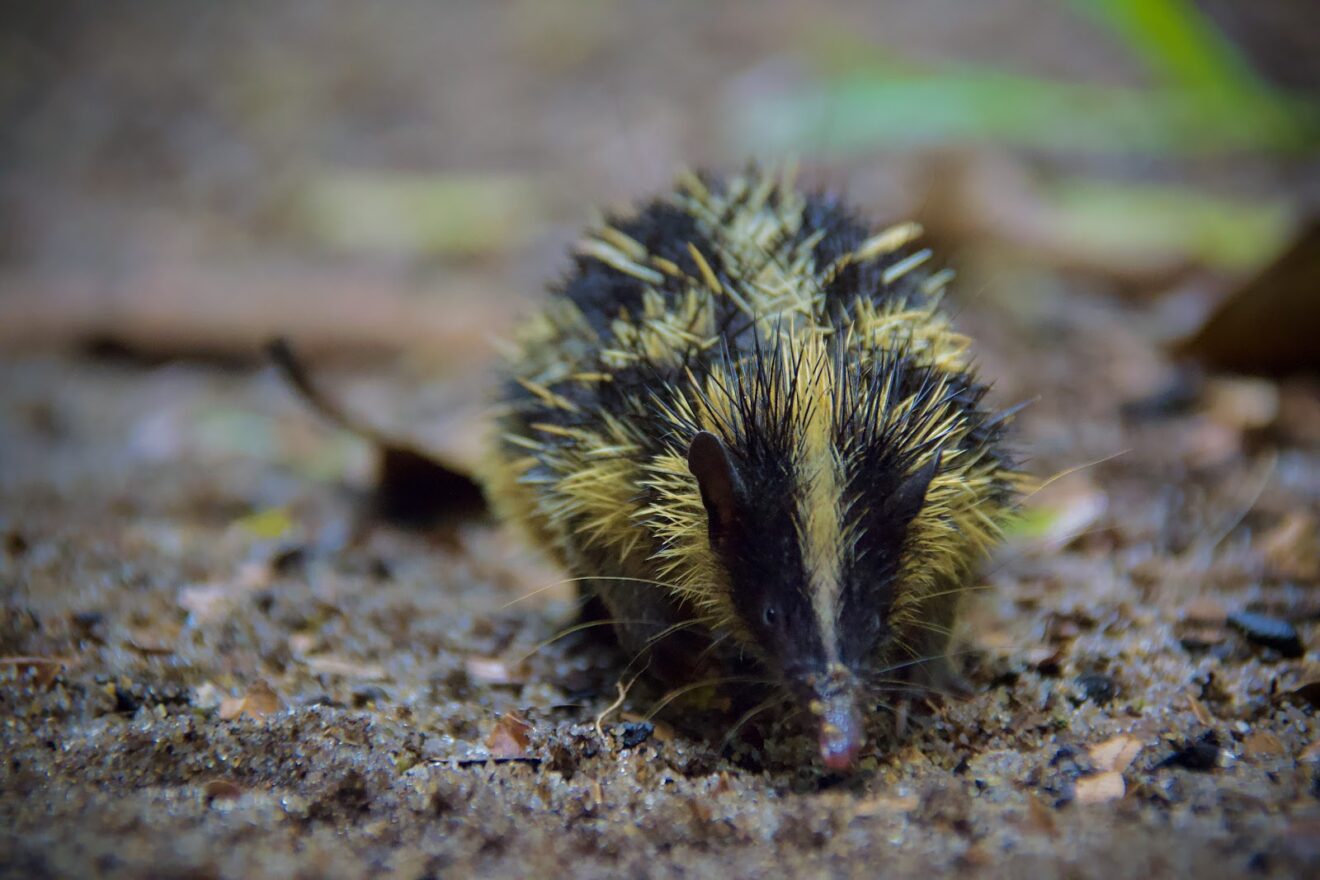
Tenrecs are a family of mammals living in Madagascar, representatives similar to hedgehogs and shrews. These small mammals are mainly nocturnal, live largely solitary and feed on invertebrates. They have adapted to different lifestyles. Among the tenrecs there are burrowing, ground-dwelling, tree-climbing and aquatic tenrecs. As a result, the animals use various ecological niches that remained unoccupied due to the lack of competitors among mammals in Madagascar. At the same time, this diversity reduces intraspecific competition and led to more than 30 species, some of which differ significantly in terms of body structure due to their different way of life. Overall, the tenrecs are a prime example of adaptive radiation. In addition, the individual types of tenrec sometimes have properties that are also rather unusual for other higher mammals. These include the strongly fluctuating body temperature and the occurrence of torpor under tropical conditions, the ability of some porcupine tenrecs to stridulate with the spines of their fur coat, as well as the sometimes extremely short succession of generations and the high number of newborns, especially in the greater tenrec.
The origin of tenrecs is still unknown. The group probably evolved on the continent, and the ancestors of the Madagascan tenrecs arrived on the island about forty to twenty million years ago. Today’s tenrecs are adapted to both the humid rain forests of the eastern part and the drier landscapes of the western part of the island. Almost a fifth of today’s species are more or less endangered.
The tenrecs form a diverse group of smaller mammals. The head-torso length varies considerably, reaching 4.7 to 6.4 cm in the smallest species, such as the pygmy tenrec or the gnome tenrec, and 26.5 to 39.0 cm in the largest species, the great tenrec. The weight varies accordingly from 2.6 to 2400 g. Most species show no particular sexual dimorphism.
Externally, two types of shapes can be distinguished. The smaller species, such as the tiger rex and ground tenrec have a shrew-like, sometimes otter-like appearance with soft fur and an elongated head. The tail length of these is variable; there are species whose tail is only a third of the body length, while others exceed it; it more than doubles the length of the rest of the body. The second group, the hedgehog tenrecs (Tenrecinae) are characterized by a hedgehog-like appearance.Their tail is only a short stump, their fur consists of bristles and spines. In general, the color of the tenrec’s fur varies from gray to brown to black, with the underside usually being lighter in color.
The tenrecs are endemic to Madagascar. Only the greater tenrec also occurs on the Mascarene Islands, Seychelles and the Comoros archipelago, but it was probably introduced there by humans in all cases. The animals inhabit a variety of habitats in Madagascar, these include the humid rainforests of the eastern and central parts of the island, the dry forests of the western part and the thornbush savannas of the south-west.
5. Tomato Frog (Dyscophus antogilii)
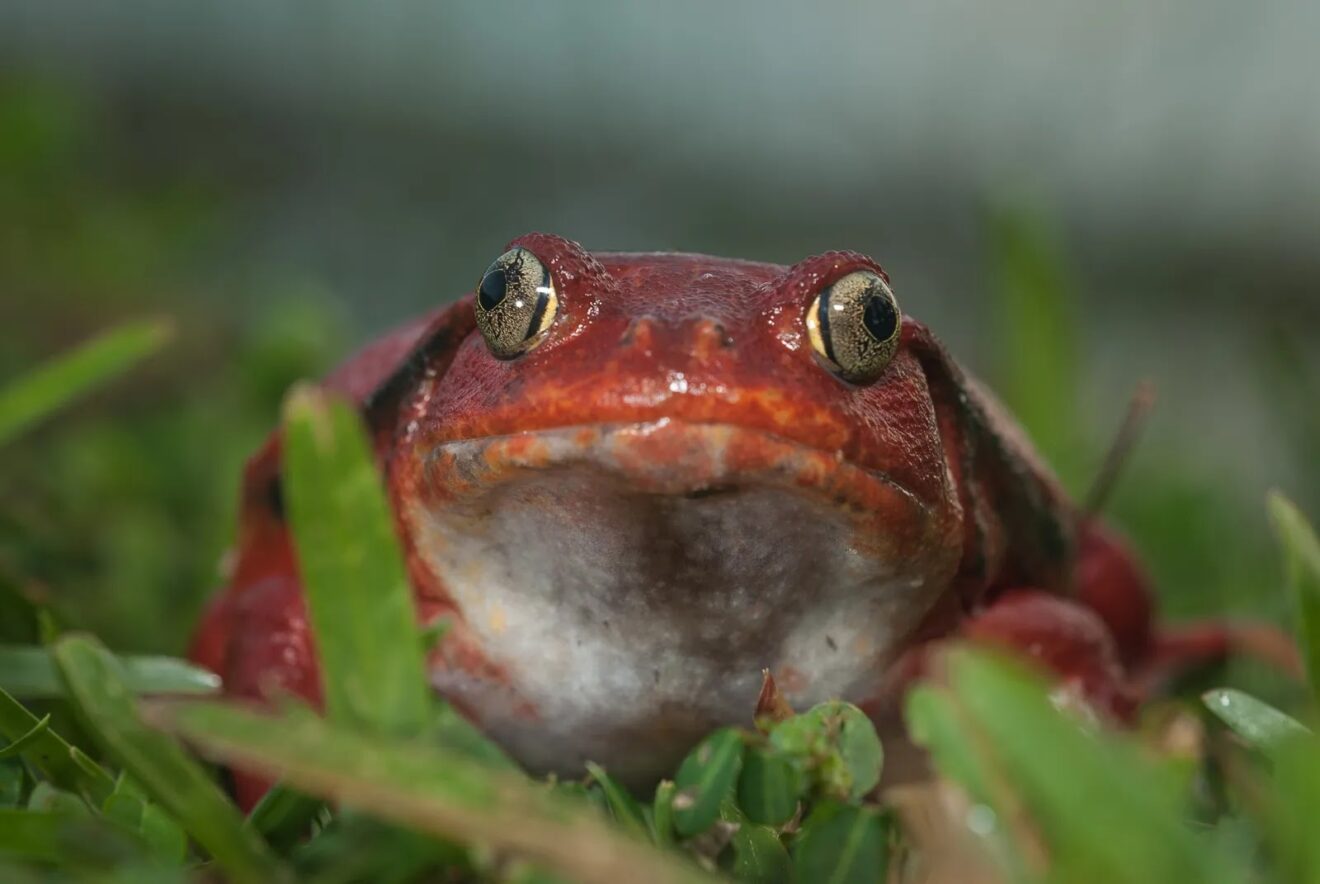
The tomato frog is a species of frog in the family Microhylidae. The species was first scientifically described by Alfred Grandidier in 1877. The species is found in northeastern Madagascar. Like most highly colored species, when attacked this toad secretes toxins that burn the mouths and eyes of its predators, and can cause allergies in humans.
The tomato frog measures 60 to 65 mm for males and 85 to 105 mm for females. Its back varies from yellow-orange to dark red. The female is more colorful and shiny than the often orange or duller orange-brown male. Juveniles are also duller and do not develop bright coloration until sexual maturity. The belly is generally lighter and yellowish. Black spots sometimes adorn the throat, and sometimes a dark line emphasizes the flanks. This species is very similar to Dyscophus guineti.
This species has a call composed of a series of short, low notes, evoking its Malagasy name: “sangongon”, a series which will be repeated at intervals. The tomato frog reaches sexual maturity at the age of 9 to 14 months. The female lays 1,000 to 1,500 small dark eggs which will hatch very quickly, about 36 hours after fertilization.
This species is endemic to northeastern Madagascar. It is found in subtropical and tropical areas of low and humid forests, on the banks of rivers, ponds, marshes, and intermittent wetlands. It can be seen near wetlands in plantations, rice fields, fields, rural gardens and even in cities sometimes. It is also present in some degraded forests and in ditches or small canals. It can live at altitudes ranging from sea level up to 600 m. It can be seen in its most natural environment, in the humid forests of the Masoala National Park (a UNESCO World Heritage Site), a park which is itself a victim of precious wood trafficking and poaching.
Population numbers vary greatly depending on location. The species has been considered “near threatened” since 2002 by the IUCN, which is concerned about the small size of its range, but notes the ability of the species to adapt to environments disturbed by human presence. This frog was the subject of international traffic, but the situation seems to be under control since; pollution remains the main threat to this species.
6. Silky Sifaka (Propithecus candidus)
The silky sifaka is one of three genera in the Indriidae family and distinguishes itself from other indriids by its almost entirely white fur. The silky sifaka used to be considered a subspecies of the diademed sifaka, until it was discovered that the species differ greatly genetically. The silky sifaka was eventually granted species status in 2007.
The silky sifaka is one of the largest sifakas and adults have a length of 93 to 105 centimeters, including the tail, which can be up to 45 to 51 centimeters. The silky sifaka has long hairs, which are white, sometimes with silver-gray patches. Due to its color the animal is called the ‘angel of the forest’. Males can be recognized by a dark red spot on the chest. During the mating season, this red spot grows bigger over the entire chest.
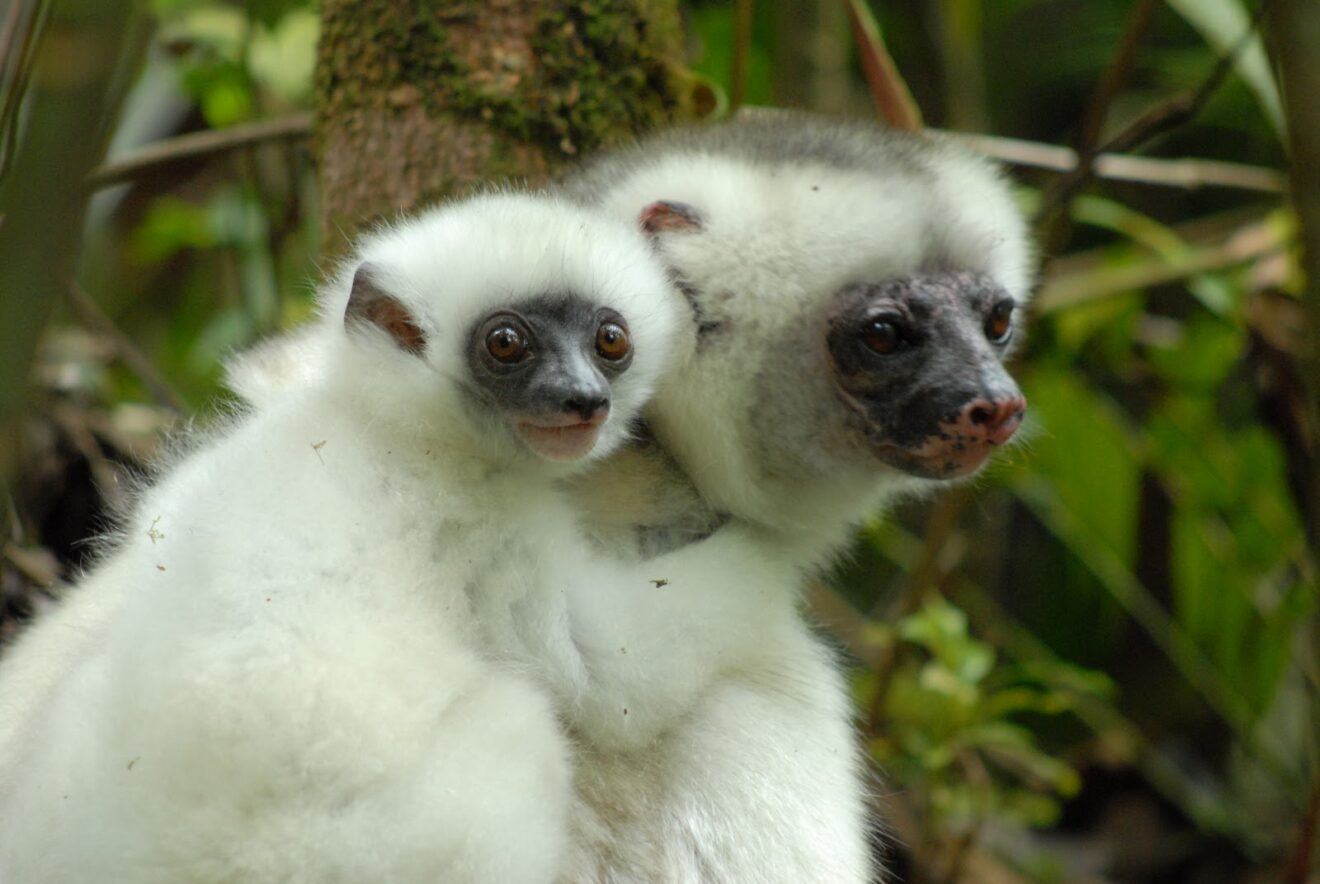
The silky sifaka spends much of the day resting and playing and also some grooming. They live in matriarchal groups of two to nine animals. A group can cover up to 700 meters in a day and can have a habitat a little over one hectare. The group maintains strong social bonds. The female takes the lead when they travel or look for food and gets the first choice.
The name sifaka comes from the characteristic ‘shif-auk’ sound the animals make when they warn others. In the event of danger from the air, they produce a hysterical roar.
The silky sifaka is a herbivore and eats fruit, seeds and leaves, but also bark, flowers and mud. He starts the day looking for food. After eating, he rests so that the food can digest.
The silky sifaka is only found in the northeast of the tropical primeval forests in Sava, in the north of Madagascar, preferably between 700 and 1,875 meters above sea level are preferred. They occur between the Marojejy massif in the north and the Antainambalana River in the south, mostly in the Marojejy National Park and the Anjanaharibe-Sud Reserve, and also in Antohaka Lava and Maherivaratra. The total habitat is estimated to be up to 2,2 square kilometers, a lot smaller than that of other sifakas. There are an estimated 1,000 silky sifakas left in the wild, of which 250 are adults and it is listed on the IUCN Red List as one of the 25 most endangered primates. The main cause is habitat loss due to forest fires and illegal logging. In addition, the silky sifaka is hunted by fossas and people.
7. Black coated Indri Lemur
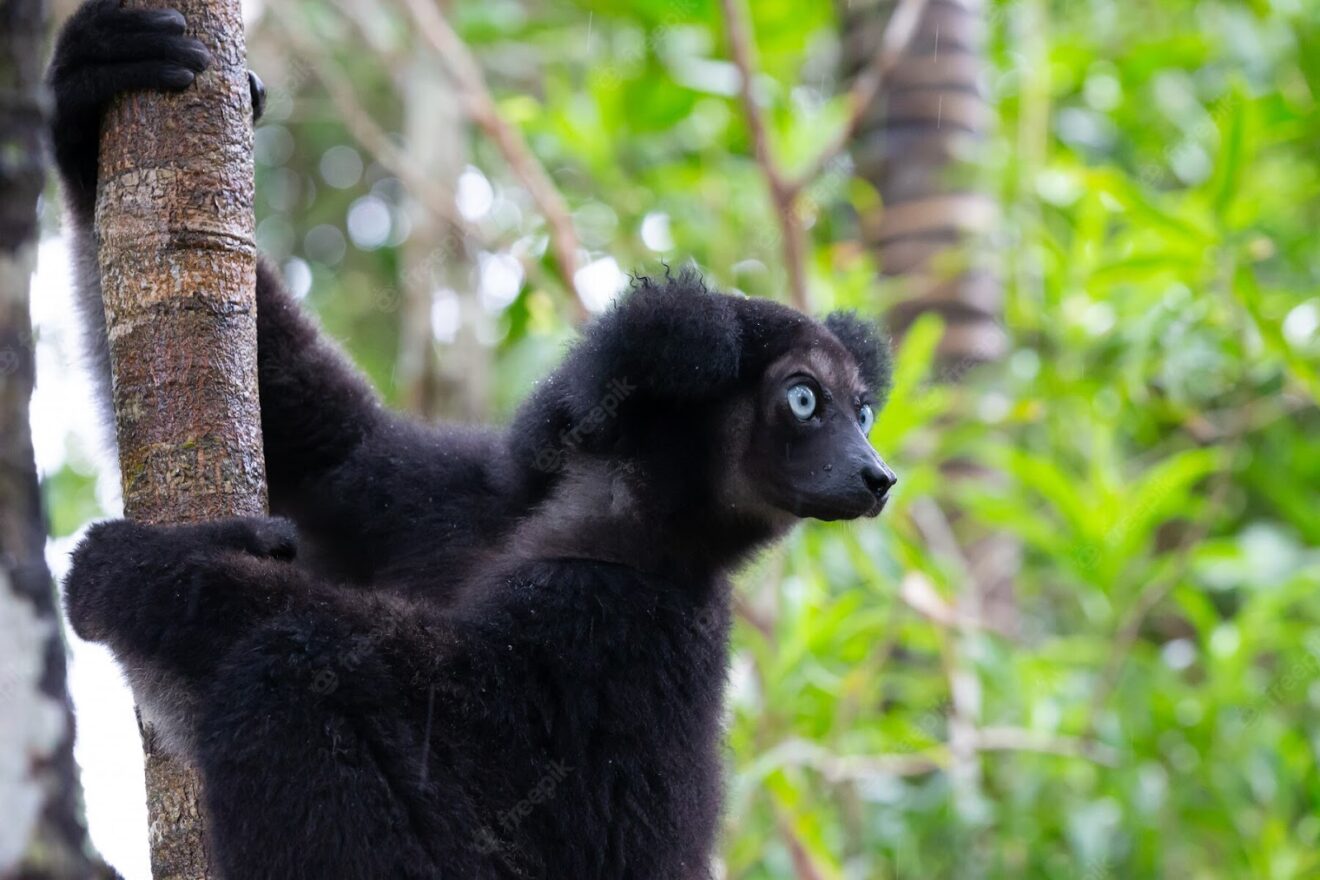
The Indri lemurs are typically white, but the ones up north have an almost complete black coat, making them look very different from their southern relatives.
The indri is the largest living prosimian and lives in the northeast of Madagascar. He is 64 to 72 centimeters long and weighs 6.5 to 9.5 kg. The indri is the only lemur with a super short tail, which is only 4 – 5 centimeters long.
The indri has black and white pattern that varies, with some dominantly black and others white. In the south offen the head, shoulders, limbs and back are completely or partially black. The face has almost no hair, showing a black skin with large eyes and a short snout. The ears have long hair. In the Sava Region the indri is almost completely black.
Indris can be found high in the trees, where they can be seen making powerful jumps in between branches and trunks. On the floor, they make sideways jumps, with their arms above their heads. They eat leaves, fruits, flowers and seeds.
Indris live in families of 2 to 5 animals: the parents and their young, with the female being the dominant one. She leads the trips, gets priority for feeding and sleeps separately from the males. The indri are famous for their loud calls, which can be heard more than two km away and can last for 4 minutes. This call probably is used to keep in touch with group members and to alert others of their presence.
The female gives birth to a single young every two – three years and carries the young on the stomach for the first few months, after which it moves to the back, until it’s about eight months old. The animals are fully grown after seven to nine years.
Indris live in the coastal and mountain rainforest of northeastern Madagascar, up to 1800 meters altitude. They used to live further west, but due deforestation they no longer live here.. Moreover, the animal is still hunted today. The indri has therefore been listed as ‘threatened’ on the IUCN Red List.
8. Humpback Whale (Megaptera novaeangliae)
The humpback whale is a marine mammal from the suborder of the baleen whales. Adult humpback whales are 12 to 16 meters in length and weigh 25 to 30 tons.

The humpback whale is known for the singing males during the mating season, which can last for days. Humpback whales are loved by tourists for their spectacular shows in which they beat the water with their fins and make large jumps. They have several inventive hunting techniques in which they work in groups. Each year, humpback whales travel long distances as they migrate from the cold, nutrient-rich polar regions to warmer waters to mate and calve. Since whale hunting was banned in 1966, the number of humpback whales has been steadily increasing. They still die from collisions with ships, fishing nets and noise pollution. Many aspects remain poorly understood, even though the animal has been studied a lot. It has become clear that it is an intelligent animal.
The humpback is easy to recognize. It has a relatively stocky appearance with long fins. Almost all humpback whales are blue-black on the upper side. In the southern waters the underside is almost completely white, in the north it’s blue-black. There is one known white humpback whale, near Australia since 1991. Research showed that this is an albino.
The humpback whale usually lives solitarily or in groups of two or three animals. They sometimes stay together in groups of up to twenty individuals or more for a few hours to hunt together. Yet the humpback whale is a social animal in its own way.
The humpback whale is known for its striking behavior at the water’s surface, where he is seen making backward and forward jumps, sometimes coming completely out of the water. These jumps are a way to get rid of parasites or are meant to communicate with other humpback whales or to impress females. Another typical behavior is striking the water with the tail fin. The humpback whale regularly sticks its head vertically out of the water to explore its surroundings.
Humpback whales mainly feed in the summer and build up a significant amount of fat reserves. During the winter they live in the warm, nutrient-poor waters and live off their fat reserves.
The humpback whale is an opportunistic hunter and is not picky. It mainly eats krill and small fish such as herring, salmon and sandeel, but also squid and other fish, and is known for its complex hunting techniques like beating the surface of the water with its fins or tail to stun its prey. He also feeds by swimming into a school of krill or fish with its mouth wide open.
There are an estimated 60,000 humpback whales, found in all the world’s oceans. The largest concentrations of humpback whales are in the Atlantic, Pacific and Arctic Oceans. There are also many humpback whales in the seas around Europe. In summer, humpback whales feed in the cold, but nutrient-rich waters in and near the polar regions, storing fat. In winter they have built up sufficient fat reserves and move back towards the equator, where they mate and calve in warm, but nutrient-poor waters.
9. Aye-Aye
The aye-aye is endemic to Madagascar and is the largest nocturnal lemur. The name ‘aye-aye’ is derived from hay-hay, the native name. At first it was thought that the aye-aye was a rodent, related to the squirrel and in 1850 it was classified as a lemur. Because it looks little like other lemurs it was first placed in a new infraorder: Chiromyiformes. The name of the family is Daubentoniidae (Ayyedes). In 1934, a fossil with the same family and genus, the extinct Daubentonia robusta, was found. In 2008 the aye-aye family was put under the superfamily Lemuroidea instead.

A full-grown aye-aye weighs 2.4 to 2.5 kg and has a total length of 30 to 37 centimeters. Its bushy tail has a length of 44 to 53 cm, giving it a total length of 74 to 90 cm. He has a dense undercoat with an off-white to gray color. The outer coat is dark gray-brown to blac. The aye-aye has a round head, a pink nose and large ears. Its eyes are orange. Like rodents, its incisors grow continuously, which is unique among primates.
The fingers and toes are long and narrow and, except for the big toes, have claw-like nails. The middle finger on the front leg is much thinner than the other fingers. It’s just bones, sinews and skin. It also has a ‘pseudo thumb’, which helps it to get a grip.
The aye-aye is nocturnal and sleeps in a homemade nest of twigs and leaves during the day, between, 7 to 20 meters high in the trees. It makes several nests. About half an hour before sunset, the males become active and start looking for food. Females become active later in the evening. They are solitary, but sometimes forage in pairs. At night, the males cover distances of two to four kilometers and usually avoid each other. The territory of a female is much smaller and when females meet, they react very aggressively. Habitat is marked by scent trails through urine and scent glands.
The aye-aye mainly eats larvae, for which he uses his long, bony middle finger to tap the bark of a tree to locate hollow spaces under the bark where larvae are found. He then gnaws a hole in the tree bark and uses his long middle finger to pick the larva out of the tree. He also eats fruits, nectar, mushrooms and nuts. With the sharp teeth he can gnaw through coconut husks and uses his middle finger to pick out the flesh. Sometimes he eats eggs from birds’ nests.
After three or four years, a female is sexually mature, but she is only fertile for a few days once a year. She attracts males by a specific call and by moving quickly around her nest. Males fight with each other to mate with her. Copulation lasts about an hour, after which the female moves to another place and repeats the calling. After a period of 160 to 170 days, she gives birth to one young, who stays with its mother for a long time. The mother teaches the young all the techniques to survive, such as searching for larvae. After two or three years the young is independent and the female mates again.
The aye-aye is only found in Madagascar, in rainforests and plantations on the east and from Ampanefana in the north to Andohahela National Park in the south. In northwestern Madagascar, it is found in dry deciduous forests and other types of forests. Deforestation has fragmented the aye-aye’s current habitat and it has been listed as an endangered species.In the past, the locals saw in the animal the reincarnation of deceased relatives. That fear protected him, but nowadays they are hunted. There is a fady (taboo) on the animal in some areas as certain people believe that they creep into their houses at night and pierce the hearts of the inhabitants with their long middle fingers.
10. Leaf-tailed Gecko
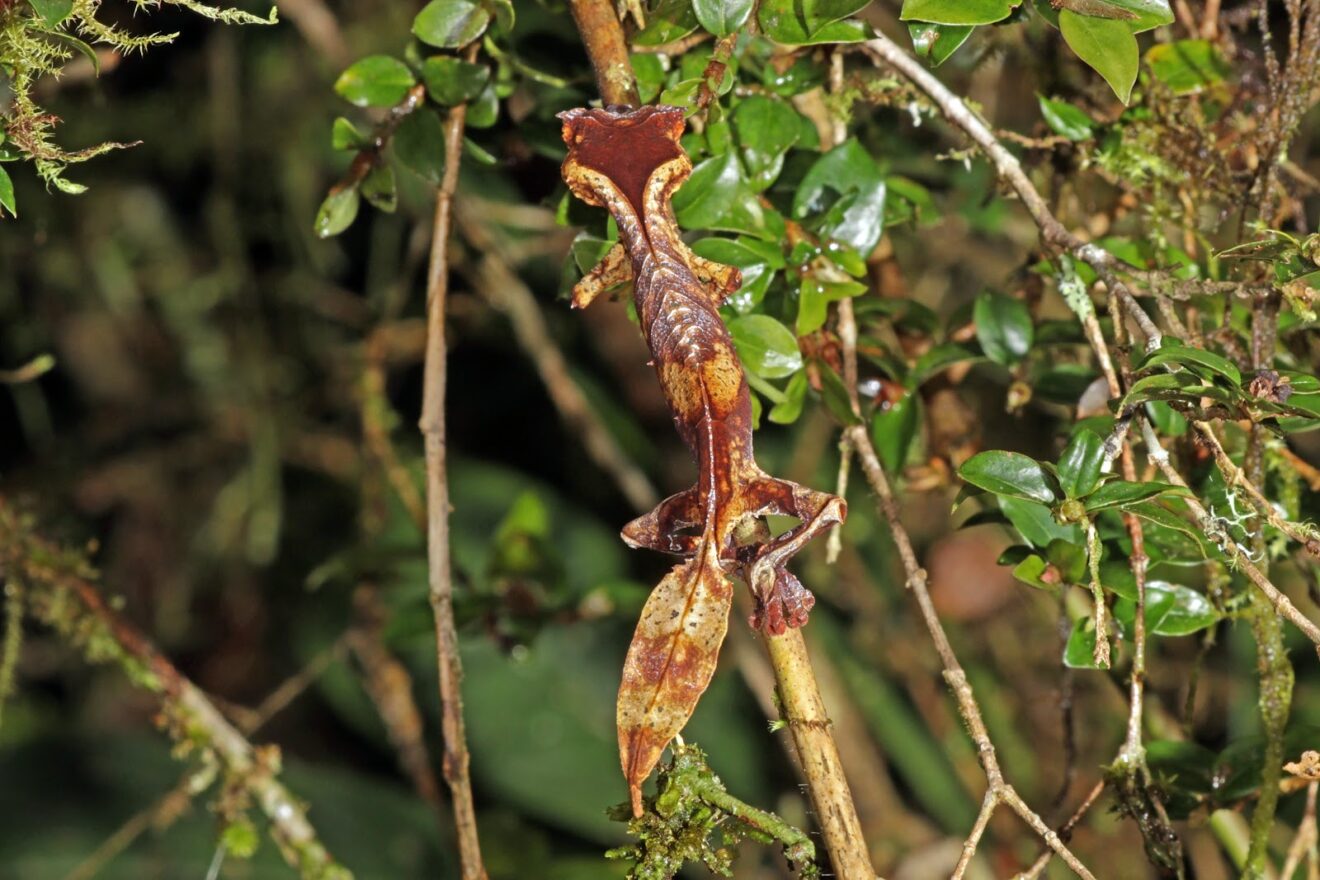
Leaf-tailed geckos are highly specialized nocturnal geckos that can grow quite large with a maximum body length of more than 25 centimeters. All species can be very different in body size and color. They all have highly camouflaged bodies that are fully adapted to the natural environment. Because of this they have a peculiar physique compared to other lizards. They are brown and have a short, flat tail. Madagascar flat-tailed gecko (Uroplatus fimbriatus) is one of the largest geckos in the world. There are 21 species. The geckos are only found in Madagascar and some nearby smaller islands. They are nocturnal and hide in trees during the day. At night they hunt insects and other invertebrates.
They live in warm, humid environments in tropical rainforests, in densely vegetated areas of the forest. Leaf-tailed geckos usually live on the trunks and branches of trees and shrubs. Some species are only known around a single mountain, while others have a very large area. The Uroplatus lineatus has an area of about 40,000 square kilometers. Leaf-tailed geckos found only on a single mountain or part of a forest are vulnerable due to their small range.
Leaf-tailed geckos have a unique form of camouflage and are virtually invisible among dead leaves or on tree bark. The tail is difficult to distinguish from the head at first glance. The legs and tail are erratic in shape and even the pupil of the eye has been modified so that the eye is less noticeable.
Leaf-tailed geckos mainly eat insects and larvae, and may also eat small lizards. Theri biggest enemies are snakes. They rely on their camouflage, even if an enemy approaches. If it suspects it has been discovered, an impressive threatening behavior is displayed. The camouflage color quickly darkens, so that the body contrasts strongly against the background. He stands on its feet to make the body appear larger. The large eyes are bulged out and the mouth is opened as far as possible. The tongue is pink and clearly stands out from the rest of the body. The tail is curled up and finally loud screaming sounds are made to keep an attacker at a distance. This behavior makes many animals run off.
A major enemy of the leaf-tailed gecko is humans, mainly through habitat destruction that affects the natural habitat. All leaf-tailed geckos are true forest dwellers that cannot survive in open areas. Large-scale forestry on the island of Madagascar is putting many species that are vulnerable under pressure. A second major threat is the trade in exotic animals. The leaf-tailed geckos are very popular with collectors due to their characteristic appearance. Because leaf-tailed geckos are rarely successful in captivity, many of the animals offered commercially come from the wild













